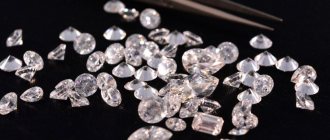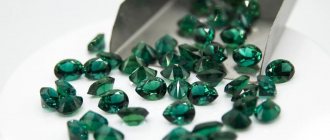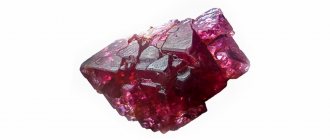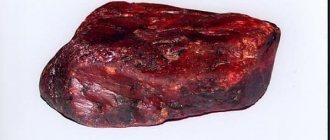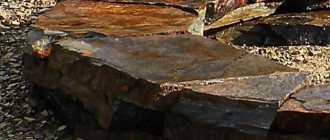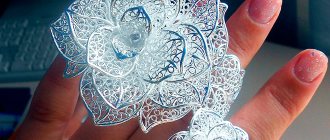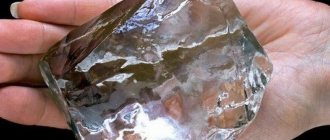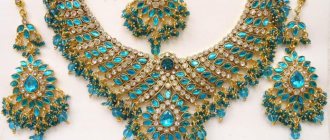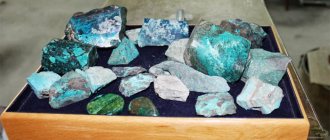Jewelry was founded in September 1991 in Moscow. Initially, the company's employees developed the design and created interior elements of jewelry with precious and semi-precious stones.
Later, Cameo began producing wedding rings, which quickly gained extraordinary popularity. Today, every third wedding ring sold in Russia is made specifically at. A wide range of products, an extensive network of regional offices, modern Italian equipment - these are the factors thanks to which Cameo has become one of the leading jewelry brands on the Russian jewelry market.
Quality and affordable prices are the company's goal.
Cameo produces jewelry that is in mass demand; it looks chic in appearance, but is also affordable for most consumers. Complex technical techniques used in production: setting stones, combining inserts, processing and shape of the alloy give rise to unique collections. These are exclusive jewelry with cubic zirconias, white sapphires, unique semi-precious stones and much more.
The jewelry company follows new products on the European jewelry market and does a lot to ensure that its products are fashionable and in demand. The company's goal is to turn the purchase of jewelry into a simple process that brings pleasure to the buyer, without much thought or hesitation. Going for jewelry is like going to the store for a cake! To achieve this, much attention is paid to pricing policy and assortment.
Kamea (Cameo)
The plant is equipped with modern Italian equipment, which produces every third wedding ring sold in Russia. Cameo is one of the leading jewelry brands on the Russian jewelry market, thanks to the organization of an extensive network of regional representative offices and the expansion of the product range. By making jewelry for mass demand, Cameo tries to sell products that look chic, but are inexpensive. Cameo produces products in the manufacture of which complex technical techniques are used: setting stones, processing and forming the alloy, combining inserts create entire collections of “illusions” that embody affordable luxury.
Subsequently, unique collections with unusual characteristics are born: jewelry with white sapphires, unique semi-precious stones, exclusive products with cubic zirconia. Today, the fashion industry is developing rapidly. Everything we wear is fashionable. And jewelry is no exception. The company's work is mainly aimed at women. The company's goal is to transform jewelry shopping into a simple, everyday process that brings only pleasure. That’s why Cameo works so hard with pricing policy and product range, and does everything to ensure that customers present the company’s jewelry in their store as profitably as possible and make money from it.
For twenty years the company has been working to achieve the most positive results in the business of the company's clients. This year Cameo celebrated its twentieth anniversary. They have achieved a lot, great opportunities are expected and they have a lot to share. Thanks to detailed research and tracking of global industry trends, Cameo creates a 100% in-demand assortment. Women from 5 to 50 years old (sometimes older), mature and young men, students, progressive youth, office clerks, personal business owners - absolutely everyone belongs to the company’s audience. The undeniable advantage of Cameo is the wide variety of assortment: products in retro style or modern minimalism, sophisticated or massive, decorated with stones or, conversely, modest and laconic, full of everything!
A big plus is our own production of classic jewelry for the Russian market, which allows us to achieve absolute perfection: these are smooth and light wedding rings, these are rigid gold bracelets and congo earrings, so beloved by Russian clients, these are gold jewelry with pearls, high-quality and charming simple. A rich range of jewelry with precious stones, light and large silver, with shiny cubic zirconia and, of course, bright and elegant semi-precious stones. However, the goal of the Cameo company is not only sales. The company also accompanies its clients after the acquisition. With each piece, Cameo also sells a “portrait of the client” who will wear the piece, when and how they will wear it.
On the official Cameo website you will find not only a technical description of the jewelry, but also a legend, which is a compelling argument for purchase. All that remains is the smallest thing - placing an order, which is a simple and pleasant procedure. “Before you know it,” the parcel has already been delivered, all the jewelry is in stock and of excellent quality. 19 stores that operate in the C&C format are located throughout Russia. The central production and office are located in Moscow. September 17 was the anniversary. In honor of the anniversary, Cameo organized a festive stand, where a presentation of the company's new jewelry products took place.
A large number of jewelry have been tested among jewelry business owners. For display at the exhibition, models were selected that meet all the requirements of the current jewelry market in quality, design and price, presented on exclusive retail equipment. In addition, in honor of the anniversary, Cameo, together with the Russian Jewelry Trade Club and the Organizing Committee of the Unified Exhibition Program “Jewelry Russia”, prepared a bonus program for Club members: a gift certificate in the amount of 20,000 rubles, which allows you to pay part of the purchase at the stand companies.
A large assortment of products is another secret of popularity.
The company's target audience is women and men of all ages, students and businessmen, progressive youth. The assortment includes jewelry in retro style and in the style of modern minimalism, sophisticated and massive, with and without stones. Thanks to the large selection, the company's products are absolutely in demand. These are wedding rings, gold bracelets and congo earrings, gold jewelry with pearls, semi-precious and precious stones.
Cameo takes care of its client even after he purchases the product. With each piece of jewelry, the company also sells a “customer portrait,” a kind of recommendation on how and where to wear the product.
At the Sibuvelier 2013 exhibition held recently in Novosibirsk, the “Victory Femininity” and “Harmonious Diversity” collections from the Cameo jewelry brand won two of the four possible medals in the exhibition competition among the best jewelry of 2013. The artistic expressiveness and spectacular color combinations of precious inserts in these collections were noted.
And according to the final data of the Assay Office for 2012, Cameo entered the top ten largest jewelry manufacturers in Russia. This rating is compiled on the basis of the mass of gold products that were received for testing and hallmarking for the entire year.
The official website of the company" published by ffurik | | publish your brand
| Tweet |
<< previous brandnext brand >>
Gemma, cameo or intaglio?
First you need to understand the terminology. What is the difference between gemma, intaglio and cameo? Gemma is a carved decoration made from a jewelry stone or shell. To create such a decoration, either a stone of the same color or a stone with a vein can be used - then the light of the image and the background will be different. Intaglio and cameo are types of gems. We call a piece of jewelry an intaglio if the design on the gem is incised, and a cameo if it is convex. Cameos are the most popular. Of course, it is not at all necessary to buy a product made of precious stone; you can use jewelry made of high-quality plastic.
Cameo making
In ancient times, the process of making cameos was extremely difficult and time-consuming. There were no hard metal cutters, so the stone was treated with abrasive mixtures made from hard stone crushed into dust and fat. The abrasive mixture was placed on the tip of the needle and gently rubbed over the surface of the stone. A stone carver could work on one cameo for a year or two, so such decorations were very expensive and were affordable only by a narrow circle of the highest nobility.
Over time, technology improved, and already in the 18th-19th centuries, cameos became available first to ordinary nobles, and then to all representatives of the middle class. Today, jewelers and stone cutters use modern diamond tools, which significantly simplify the process of processing stone blanks. However, the latest equipment only serves as an addition to the talent and artistic flair that allow craftsmen today to make jewelry that is in no way inferior to the best examples of antiquity.
Materials and stories
As a rule, the main materials for the manufacture of ancient and modern cameos are semi-precious and ornamental stones with a layered structure - carnelian, agate, onyx and sardonyx. There are also single-color cameos, but they do not look as impressive and impressive, representing ordinary bas-relief images. By the way, products with a concave, high-relief pattern (intaglios) are also found, but they have nothing to do with cameos. As a rule, signet rings are made using this technique.
Initially, cameos were images of ancient gods, goddesses and heroes, scenes from ancient Greek and Roman myths, as well as portraits of rulers and representatives of the highest nobility. Much less often they featured images of real or mythical animals and elegant plant scenes. Currently there are no restrictions on the subject of images. You can order a master carver a picture of a cute cat or your own portrait copied from a photograph.
What to wear with a cameo now?
If you don't want to look like a historical reenactor, cameos should be combined with simple clothes. Avoid ruffles in printed fabrics. Better try adding a few cute chains with discreet pendants to the cameo pendant, or combine the cameo with metal earrings of the same color as the cameo setting.
Here are some successful images using cameos:
- Plain sweater + even dress pants + massive earrings + cameo pendant;
- Collared shirt + formal sundress + cameo brooch;
- Coat + checkered scarf + cameo brooch;
- Dark colored jacket + cameo ring.
A little about the history of the cameo
These decorations were popular in Ancient Greece and Rome. They were used as clasps for cloaks, neck decorations and inserted into rings. In addition, this accessory could serve as a signet and be a symbol of its owner. The most popular subjects for cameos in Ancient Greece and Rome were amorous, mythical and religious, and political-military.
The most famous gem of that period is the Gonzaga cameo, which is now kept in the Hermitage. This cameo is made of three-layer carnelian and depicts the profiles of Ptolemy II Philadelphus and Arsinoe II.
On the territory of the Apennine Peninsula, the fashion for cameos has never stopped. Italian gems thundered throughout Europe and Asia for many centuries. At the end of the 17th century, a fashion arose to depict loved ones on cameos, and in the mid-18th century, everyday scenes gained popularity.
Now in many people's imagination cameos are associated with the glittering Victorian era. During this period, these jewelry became so fashionable that absolutely everyone wanted to wear them, but not everyone had the money to buy or order a cameo for themselves. Therefore, many craftsmen sold imitation cameos made of wood, created paintings in the form of characteristic images, or made decorations from paper! Later, a special type of portrait was formed - the artist created the silhouette of the customer from a contrasting material.
What stones were used?
Since these were highly valued items, they were usually made from precious and semi-precious stones such as carnelian, agate, jasper, chalcedony, stone crystal, amethyst, garnet and sapphire. “Their material, size and color will reflect the wealth and taste of the patron,” adds Max Bernheimer.
Greek spotted yellow jasper scarab with grasshopper, attributed to Dexamenes or a close follower, Classical period, circa late 5th century BC. 7/8 inch (2.1 cm) long. Sold for $519,000 on April 29, 2021 at Christie's New York
Precious stones were usually set in gold, silver or bronze frames, sometimes framed with a simple band, and sometimes with a more complex design. Although many of them have lost their original fastenings, some can still be found in their original form.
When and where were they made?
This tradition began in Ancient Mesopotamia, about 5,000 years ago, when stamp seals and cylinder seals were pressed and rolled into wet clay. From there it gradually spread throughout Minoan and Mycenaean Greece, Persia and Egypt.
Minoan blue chalcedony tabloid seal with three swans, late Palace period, circa 16th century BC. e. ¾ in length (1.9 cm). Sold for $118,750 on April 29, 2021 at Christie's New York
Around the 16th century BC, the Minoans began making small rectangular stamp seals. The tradition was lost towards the end of the Bronze Age, but was revived in the 6th century BC. e. with small oval intaglia, usually in the shape of a scarab beetle with an engraved underside.
During the 5th century BC. e. the details on engraved gemstones became finer, and by the 3rd century BC. e. The conquests of Alexander the Great allowed a flood of new exotic stones to spread throughout the Hellenistic world.
Greek blue chalcedony scarab with Aphrodite, Classical period, circa 4th century BC. 1⅛ in (2.7 cm) long. Sold for $187,500 on April 29, 2021 at Christie's New York
The Romans continued the Hellenistic tradition for intaglia and cameo. “The Roman writer Cicero once observed that people wore portraits of their favorite philosophers on their rings,” Bernheimer says.
The Romans also began making glass from which cameos could be carved, allowing for consistent and predictable layers of color. “The most famous example of this tradition is the Portland Vase in the British Museum, which inspired Josiah Wedgwood to create monochromatic pottery,” adds the specialist.
How were they made?
The earliest engraved gemstones were carved by hand using simple iron tools, including sharpened drills and cutting wheels used in combination with fine abrasive sanding powders. The diamond-tipped drill was introduced in the 5th century BC. e., but did not become publicly available many centuries later.
Greek carnelian scarab with naked archer, Archaic period, circa early 5th century BC. 3/8 inch (1 cm) long. Sold for $47,500 on April 29, 2021 at Christie's New York
Some gemstones contain a small hole drilled in the center, allowing it to be mounted on a rotary device so that they can be worn with the engraved side against the finger. They could then be removed and the stone turned.
